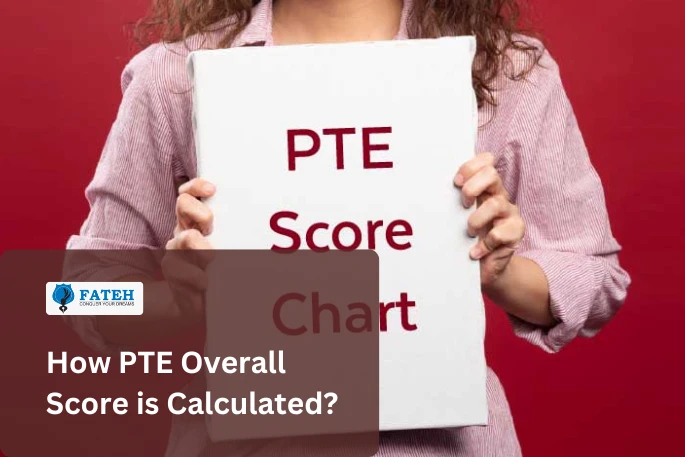Introduction
The PTE (Pearson Test of English) Academic is a recognised English proficiency examination for visas and university applications, with minimum score thresholds differing according to the visa category and institution. Taking this test is the best choice when you want to study, work, or settle in countries like the United Kingdom. Additionally, it is crucial for those taking the PTE exam to have a solid understanding of the scoring methodology, as this provides them with valuable insights into how their performance is evaluated.
In this article, we will delve into the specifics of the PTE scoring system, shedding light on its various components, scoring scales, and score interpretations.
Overview of PTE Score Report
- Score Range: Each section is evaluated on a scale from 10 to 90, with 90 representing the maximum possible score. The overall score is weighted according to how well you performed in each segment, rather than an average of the four modules.
- Communicative Skills: The PTE Academic exam evaluates four core language skills: Listening, Reading, Speaking, and Writing. Each skill is assigned a score based on performance in a series of tasks designed to evaluate real-life communication abilities.
- Enabling Skills: Enabling skills like Grammar, Oral fluency, Pronunciation, vocabulary, and spelling are additional competencies that facilitate the development and evaluation of primary language skills. These skills impact your scores in communication, particularly in speaking and writing.
- Skills Breakdown by Task: While not always shown in the official report, some practice platforms or detailed reports may show how you performed on individual task types like Read Aloud, Repeat Sentence, Essay Writing, Summarise Spoken Text, Fill in the Blanks, etc.
Understanding PTE Scoring Criteria
The PTE Academic exam evaluates each activity according to a number of factors, such as delivery, language use, format adherence, and topic accuracy. A summary of these components is provided below:
Content: Describes how well your solution addresses the task prompt in terms of its completeness, accuracy, and relevancy.
Form: Consists of proper formatting, including word count and length of spoken response.
Language Use: Addresses vocabulary appropriateness and grammatical correctness.
Pronunciation and Fluency: Natural flow and voice clarity are assessed for speaking tasks.
Spelling and Structure: Crucial for writing assignments, influencing both enabling and communicative scores.
Each task is intended to evaluate one or more of these domains.
Methodology of Score Calculation
- Scoring Framework: The Global Scale of English (GSE) provides the basis for the scoring. The 10–90 scale is used to express both the total score and each individual segment score, enabling uniform benchmarking across test attempts and applicants.
- Task-level Scoring: The PTE Academic exam assigns scores to each assignment according to predetermined standards based on Content, Form, Language usage and more. Tasks may evaluate multiple skills at once. For instance-
- “Repeat Sentence” affects speech and listening.
- “Summarise Spoken Text” has an impact on grammar, writing, and listening.
- “Write from Dictation” evaluates written language, spelling, and listening skills.
- Converting a Raw Score – A raw score is produced by each response, which is subsequently converted to a common scale using statistical models to ensure fairness across different test versions.
- Weighted Aggregation- According to the importance of the tasks and the skill coverage, different weights are assigned to each task. High-weight tasks such as Repeat Sentence and Write from Dictation considerably influence your score.
- Overall Score Calculation- It is crucial to remember that the final total result is not only the average of the four values for the communicative skills. To make sure the scoring method is dependable and consistent, Pearson uses sophisticated machine learning algorithms that have been trained on thousands of human-rated responses. These algorithms use speech recognition and natural language processing to assess the form and content of responses.
Sample Score Calculations
Here’s a sample PTE score calculation to help you understand how individual task scores contribute to the final result:
This is the breakdown of the communicative skills (Listening, Reading, Speaking, Writing)
| Module | Average Score |
|---|---|
| Listening | 76.67 |
| Reading | 74.50 |
| Speaking | 79.00 |
| Writing | 81.00 |
Now, let us calculate the average score of all four modules- 76.67 + 74.50 + 79 + 81/ 4 = 77.79
Here’s the visual representation of the scores of all four modules: –

Importance of PTE Overall Score
- University Admissions: Due to the fact that the PTE Academic test is recognised and accepted by many countries for the purpose of university admissions, it is an extremely significant asset for students who are interested in studying abroad. Universities typically require a minimum overall PTE score and may also have specific band requirements for each module.
- Immigration and Visas: An overall PTE score is extremely important for immigration and visa applications since it reflects your level of English language proficiency, which is usually a requirement for a variety of visa categories. Additionally, the likelihood of acceptance can be enhanced by obtaining a higher PTE score, which can result in a greater number of points in visa applications.
- Professional Licensing: Certain professions, like nursing or teaching, require proof of English proficiency. Furthermore, licensing bodies may demand a high overall score along with minimums in each skill.
- Scholarships and Funding: Some scholarships are awarded based on academic excellence, which includes language proficiency. Thus, a high PTE score can strengthen your application and improve your chances of attaining scholarships and funding.
- Competitive Edge: Particularly in circumstances when there is a great deal of competition, having a high overall score on the PTE can provide you with an advantage over other applicants who have lower scores. Moreover, a strong overall score demonstrates your ability to communicate effectively in English, which can be valuable for job opportunities and internships.
Tips for Improving PTE Scores
Improving your PTE Academic score involves a strategic approach to mastering both the test format and your English language skills. Here are some effective tips that one must follow to achieve their desired results:
1. Speaking Tips:
- Enhance Fluency: Communicate seamlessly, minimising pauses and filler words.
- Improve Pronunciation: Utilise applications or resources to receive feedback on your pronunciation.
Record Yourself: Engage in exercises such as “Read Aloud” and “Describe Image,” then review your recordings. - Use Natural Intonation: Avoid sounding robotic, speak as you would in a conversation.
2. Writing Tips:
- Give structure to your Essays: Use clear introductions, body paragraphs, and conclusions.
- Focus on Grammar and Vocabulary: Use varied sentence structures and precise vocabulary.
- Practice Summarising: For “Summarise Written Text,” keep it concise and focused.
- Time Management: Practice writing essays within the time limit.
3. Reading Tips:
- Skim and Scan: Learn to quickly identify key information.
- Practice Fill-in-the-Blanks: These tasks test grammar and vocabulary.
- Understand Question Types: Know the difference between multiple-choice, reorder paragraphs, etc.
- Read Daily: Engage with academic articles, newspapers, and journals.
4. Listening Tips:
- Note-Taking Skills: Practice shorthand and symbols to capture key points.
- Listen to Varied Accents: PTE includes British, American, and Australian accents.
- Focus on Keywords: Especially in “Write from Dictation” and “Summarise Spoken Text.”
- Practising Mock Tests: Practising mock tests stimulates real test conditions to build stamina and accuracy.
5. General Strategies:
- Use Official Practice Materials: Pearson’s scored practice tests are highly effective.
- Understand the Scoring System: Know which tasks carry more weight.
- Take Mock Tests: Identify your weak areas and track progress.
- Get Feedback: Use AI tools or tutors to evaluate your responses.
Conclusion
FAQs
| IELTS Band | Equivalent PTE Score |
|---|---|
| 6.5 | 58 – 64 |
| 7.0 | 65 – 72 |
| 7.5 | 73 – 78 |
| 8.0 | 79 – 82 |
Yes, it is moderately easy for students with decent grammar and vocabulary, good pronunciation and fluency and regular practice with mock tests to attain a score of 65 in PTE. However, it is not automatic; you need familiarity with the PTE format, scoring algorithm, and time management to achieve that.
No, it could be challenging to get a score of 79 in each module, which is equivalent to IELTS 8.0 bands. To attain a score of 79 in each segment, the student must demonstrate near-native fluency, have a good hold of grammar, vocabulary, and comprehension, high-speed reading, precise listening, and structured writing. It requires focused training of 1–3 months along with an advanced vocabulary, accent clarity and mastery of high-scoring tasks (e.g., Repeat Sentence, Write Essay, Summarise Spoken Text).
SHARE THIS POST
Related Posts
Where we are

Delhi, Ahmedabad, Bangalore, Chennai, Hyderabad, Kolkata, Mumbai, Pune, Chandigarh

